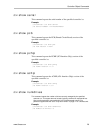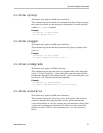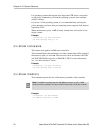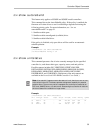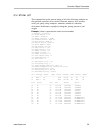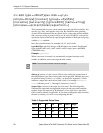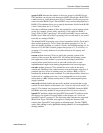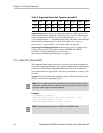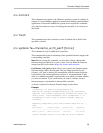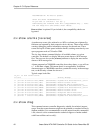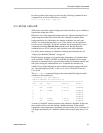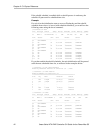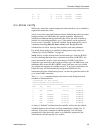
Controller Object Commands
www.3ware.com 37
group=3|4|5|6 indicates the number of disks per group for a RAID 50 type.
(This attribute can only be used when type=raid50.) Recall that a RAID 50 is
a multi-tier array. At the bottom-most layer, N number of disks per group are
used to form the RAID 5 layer. These RAID 5 arrays are then integrated into a
RAID 0. This attribute allows you to specify the number of disks in the RAID
5 level. Valid values are 3, 4, 5 and 6.
Note that a sufficient number of disks are required for a given pattern or disk
group. For example, given 6 disks, specifying 3 will create two RAID 5
arrays. With 12 disks, specifying 3 will create four RAID 5 arrays under the
RAID 0 level. With only 6 disks a grouping of 6 is not allowed, as you would
basically be creating a RAID 5.
The default RAID 50 grouping varies, based on number of disks. For 6 and 9
disks, default grouping is 3. For 8 disks, the default grouping is 4. For 10
disks, the default grouping is 5, and for 12 disks, the default grouping is 4. In
the case of 12, the disks could be grouped into groups of 3, 4, or 6 drives. A
grouping of 4 is set by default as it provides the best of net capacity and
performance.
noscan attribute instructs CLI not to notify the operating system of the
creation of the new unit. By default CLI will inform the operating system.
One application of this feature is to prevent the operating system from
creating block special devices such as /dev/sdb and /dev/sdc as some
implementations might create naming fragmentation and a moving target.
nocache attribute instructs CLI to disable the write cache on the newly
created unit. Enabling write cache increases write performance at the cost of
potential data loss in case of sudden power loss (unless a BBU or UPS is
installed). By default the cache is enabled. To avoid the possibility of data loss
in the event of a sudden power loss, it is recommended not to set nocache
unless there is a BBU (battery backup unit) or UPS (uninterruptable power
supply) installed.
autoverify attribute enables the autoverify attribute on the unit that is to be
created. For more details on this feature, see “/cx/ux set autoverify=on|off” on
page 61. This feature is not supported on model 7000/8000. On model 9000,
the JBOD autoverify attribute is not persistent (does not survive reboots).
ignoreECC attribute enables the ignoreECC/OverwriteECC attribute on the
unit that is to be created. For more details on this feature, see “/cx/ux set
ignoreECC=on|off” on page 62. The following table illustrates the supported
Model-Unit Types. This table only applies to setting this feature at unit
creation time. IgnoreECC only applies to redundant units.
For the 7/8000
series, this setting is only applicable during rebuild; it is not applicable
during creation.



